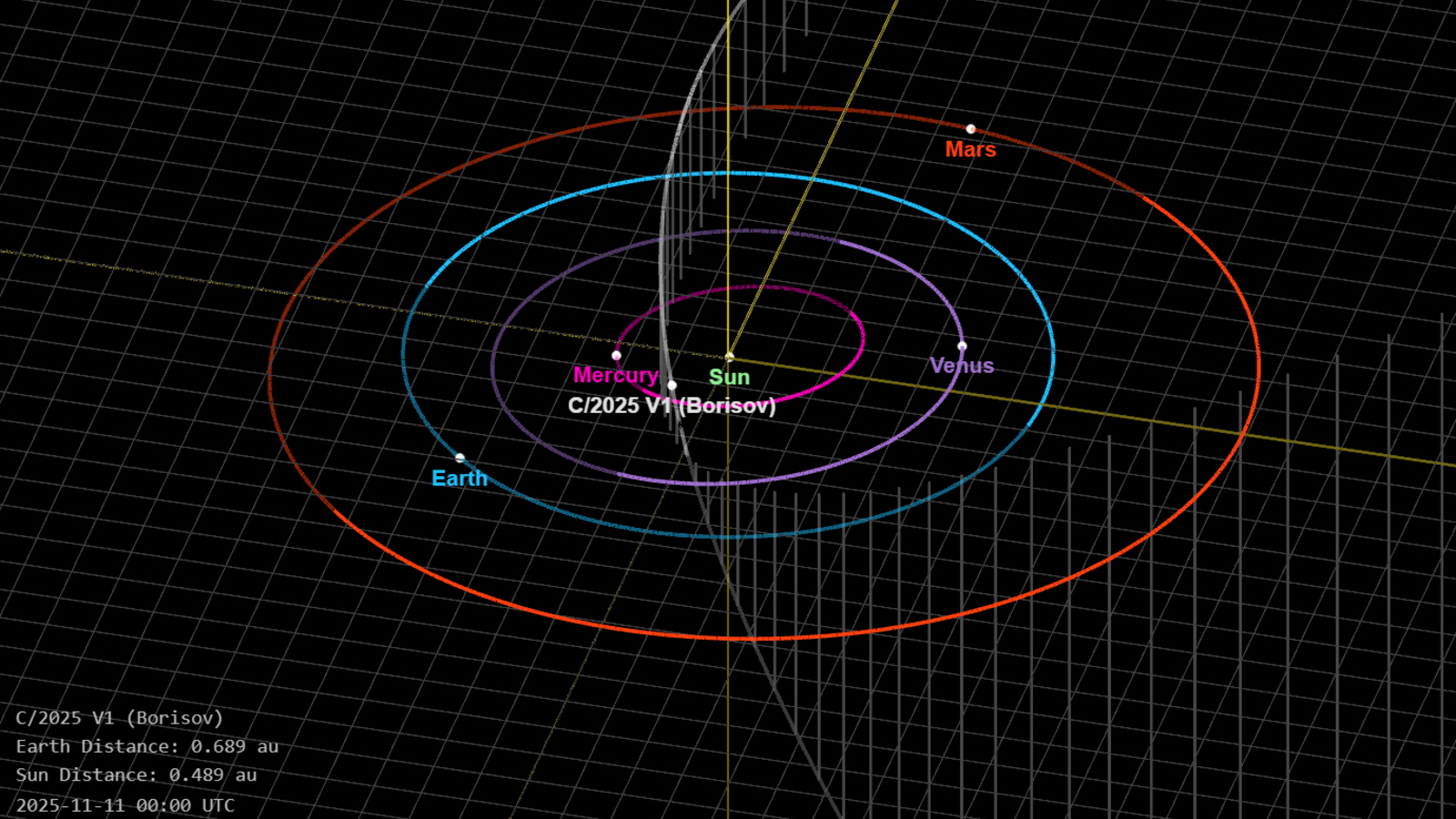Refresh
New ‘almost interstellar’ comet approaches Earth

Hello! Senior Staff Writer Harry Baker here. I’ve been covering the infamous alien comet 3I/ATLAS a lot since it was first discovered in early July, so I was surprised to hear of a new “almost interstellar object” that is due to make its closest approach to Earth tomorrow (Nov. 11), especially when some people were speculating that it could be an alien probe.
For the record, this newly discovered comet, dubbed C/2025 V1 (Borisov), is definitely NOT an interstellar object (ISO). But it does share a few similarities with 3I/ATLAS, including a high eccentricity and a vanishing tail. As for it being an alien spacecraft, even renowned alien-hunter Avi Loeb — who has been promoting this theory for months — says that it is unlikely.
And in a completely unrelated coincidence, the new comet was discovered by Gennadiy Borisov, who also discovered the second-ever ISO and 3I/ATLAS’s predecessor “Comet Borisov” in 2019.
Check out the full story here.

Harry Baker
Cosmically, we may have already peaked

It’s good to be in something from the ground floor, but humanity may have come too late for that. Or that’s at least the latest from the Euclid and Herschel telescopes, which have found that star formation has already peaked in our cosmos.
By taking the most comprehensive temperature reading of our universe yet, the space telescopes revealed that galaxies have grown slightly cooler as their star formation rates eased off over the past 10 billion years.
That means that our universe is on course to becoming totally quenched. But before any of us spiral into existential crisis, it won’t be for an unimaginably long time. In the meantime, we can all get therapy, or maybe just feed the ducks.
You can read the full story here.
Comet sense?

Seems like pretty much everyone wants fresh updates on Comet 3I/ATLAS these days.
Our solar system’s third-ever recorded interstellar visitor is fascinating — at more than 7 billion years old it’s so irradiated that we may never be able to pin down exactly where it came from. But the question on everyone’s lips, and in our inboxes, is whether or not it’s an alien probe.
I’d really love to tell you otherwise, but the answer from most scientists is no, almost definitely not.
You don’t have to take that from me, though. Here’s an article by radio astronomer Laura Driessen on why extraterrestrial speculation is the least interesting question about this truly strange comet.
You can give the story a read here.

Ben Turner
COP30 kicks off

The opening ceremony of COP30 has wrapped up in Belém, Brazil. You can watch it here. It wasn’t like an Olympic opening ceremony or anything like that — not one singing headless Marie Antoinette in sight. Still, there were a couple of impassioned speeches and traditional musical performances.
Most importantly, this year’s major climate conference is officially underway. Simon Stiell, the UN Climate Change Executive Secretary, highlighted the progress humanity had made since the signing of the Paris Agreement 10 years ago at COP21, during which world leaders promised to limit global warming to preferably below 1.5 degrees Celsius (2.7 degrees Fahrenheit) and well below 2 C (3.6 F). However, as the UN announced last week, we’re still expected to overshoot the 1.5 C target.
“We must move much, much, faster on both reductions of emissions and strengthening resilience,” Stiell said. “The science is clear: we can and must bring temperatures back down to 1.5C after any temporary overshoot. Lamenting is not a strategy. We need solutions.”
Stiell will be looking for countries to collaborate on those solutions this week, but as Ben noted this morning, many leaders are no-showing this year’s conference. Among the notable absentees are President Donald Trump, China’s Xi Jinping and India’s Narendra Modi — the heads of the three biggest emitting countries.
In case you missed it
—Ram-shaped teapot from ancient Canaanite cult discovered near ancient city of Armageddon
A very interesting teapot.
—Antibiotic found hiding in plain sight could treat dangerous infections, early study find
Scientists have discovered a new antibiotic compound that shows promising activity against drug-resistant infections, so that’s good.
—NASA’s ultraquiet supersonic ‘flying swordfish’ makes history with first test flight
NASA has unveiled an experimental supersonic plane that looks like a swordfish. Swordfish are among the fastest animals in the ocean, but their commonly cited swimming speeds are very unreliable. NASA’s new plane reached a top speed of about 240 miles per hour (386 kilometers per hour).
A terrifying, but potentially very useful, walking chair.
—How to watch ‘Kingdom’ — TV and streaming details for David Attenborough’s new BBC series
New nature series narrated by the 99-year-old Sir David Attenborough.

Patrick Pester
Mysterious Andean holes explained

Some 5,200 holes sit in ordered grids along southern Peru’s Serpent Mountain, many of them dating back more than a thousand years. So what could explain them? Long-forgotten rituals? Fog capture technology? Human sacrifices? Aliens?
A new suggestion made by archaeologists posits that the real answer isn’t quite that exciting (although it’s still pretty cool): The holes were likely used as accountancy tools in barter markets for goods along trade routes.
You can read the full story here.
Giza break

Two voids found on the eastern side of Egypt’s Pyramid of Menkaure could point to a second entrance to the ancient tomb, tests that used electrical currents and ultrasonic waves have hinted.
You can check out the full story here.
The weekend’s biggest news
We can’t always bring you breaking science news as it happens — sometimes our loved ones, days off and sleep schedules get in the way. Here’s some of the biggest science news that happened over the weekend:
- A powerful 6.9 magnitude earthquake rattled the northern coast of Japan on Sunday (Nov. 9). Thankfully, there have been no immediate reports of injuries or damage, no abnormalities at the two nuclear power plants in the area, and a tsunami warning following the quake was downgraded.
- Health officials are investigating 13 cases of infant botulism across 10 states linked to a recalled baby formula.
- Blue Origin’s New Glenn rocket was scheduled for launch on Sunday (Nov. 9) but it has been delayed until Wednesday (Nov. 12) due to poor weather conditions. The launch will be the first big test for the rocket’s first NASA mission, and a statement of intent for the company’s founder Jeff Bezos against competitor SpaceX.
Monkey business is closed

Two weeks ago, Patrick covered news of several lab monkeys that escaped from an overturned truck in Mississippi that were allegedly diseased and dangerous.
On Friday night, we finally got news that the last of these monkeys has been tracked down following a report from a resident whose dog alerted her to its presence. Five of the escaped rhesus macaques were sadly killed by police, yet authorities say that this monkey was “successfully recovered.”
Good COP, bad COP

Good morning, science fans! Ben here, back for another round of updates on the latest science updates from around the world.
While we’re speaking of the pale blue dot that we call home, it’s in a spot of trouble due to human-caused climate change, as it speeds toward near-certain overshoot of climatic guard-rails set by 2015’s Paris Agreement. That’s why delegations from 194 countries are meeting in Brazil for the UN’s COP30 conference, making yet another attempt to forge better plans to stay within the agreement’s limits and phase out fossil fuels.
This year’s conference promises to be particularly contentious, with many leaders being no-shows and the Trump administration having exited the process entirely.
Where that leaves this conference is entirely unclear: Brazil insists that this year’s conference will be one of “implementation”, whereby countries focus on what they can contribute toward real-world impacts instead of striving toward longwinded, often defanged, consensus. Whether that means some countries can get away with contributing very little, and what can be done to counteract this, remains unclear.

Ben Turner
Source link

